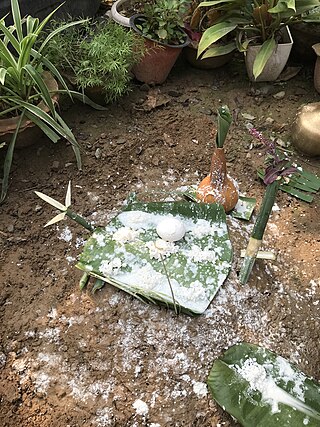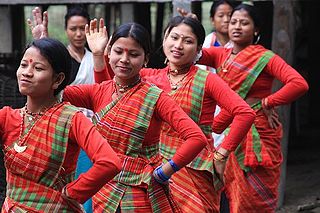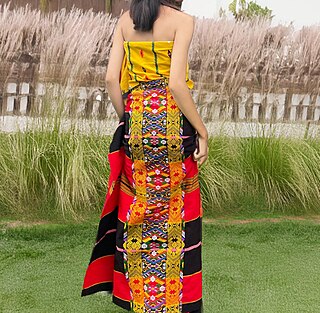Related Research Articles

Bihu is of three types and it is an important cultural festival unique to the Indian state of Assam – 'Rongali' or 'Bohag Bihu' observed in April, 'Kongali' or 'Kati Bihu' observed in October or November, and 'Bhogali' or 'Magh Bihu' observed in January. The festivals present an admixture of Tibeto-Barman, Austroasiatic and Indo-Aryan traditions entwined so intricately that it is impossible to separate them—festivals which are uniquely Assamese to which all communities of Assam had contributed elements. The Rongali Bihu is the most important of the three, celebrating spring festival. The Bhogali Bihu or the Magh Bihu is a harvest festival, with community feasts. The Kongali Bihu or the Kati Bihu is the sombre, thrifty one reflecting a season of short supplies and is an animistic festival.

Mājuli or Majuli is a large river island located in Assam, India. It is formed by the Brahmaputra River to the south and east, the Subansiri River to the west and an anabranch of the Brahmaputra River called Kherkutia Xuti to the North.

The Adi people are one of the most populous groups of indigenous peoples in the Indian state of Arunachal Pradesh. A few thousand are also found in the Tibet Autonomous Region, where they are called the Lhoba together with some of the Nyishi people, Na people, Mishmi people and Tagin people.

The Garo people are a Tibeto-Burmese ethnic group who live mostly in the Northeast Indian state of Meghalaya with a smaller number in the neighbouring Bangladesh. Historically, the name Garo was used for a large number of different peoples living on the southern bank of Brahmaputra River, but now refers primarily to those who call themselves A•chik Mande or simply A•chik or Mande and the name "Garo" is now being used by outsiders as an exonym. They are the second-largest tribe in Meghalaya after the Khasi and comprise about a third of the local population.

A harvest festival is an annual celebration that occurs around the time of the main harvest of a given region. Given the differences in climate and crops around the world, harvest festivals can be found at various times at different places. Harvest festivals typically feature feasting, both family and public, with foods that are drawn from crops.

The Tani people are a Sino-Tibetan ethnic group of peoples, which includes the Adi, Apatani, Galo, Mising, Nyishi and Tagin, who share common beliefs, ancestry, and Tani languages and live in the Indian states of Arunachal Pradesh and Assam, as well as the Tibet Autonomous Region in China.
Ethnic minorities of Bangladesh or loosely termed indigenous people of Bangladesh are ethnic minorities in Chittagong Hill Tracts (southeastern), Sylhet Division (northeastern), Rajshahi Division (west), and Mymensingh Division (north-central) areas of the country. They are assumed as indigenous and the tribal races, total population of ethnic minorities in Bangladesh was estimated to be over 2 million in 2010. They are diverse ethnic communities including Tibeto-Burman, Austric and Dravidian people.

Magh Bihu (also called Bhogali Bihu or Maghar Domahi is a harvest festival celebrated in Assam, North-East India, which marks the end of harvesting season in the month of Magh. A bonfire is lit for the ceremonial conclusion and prayer to the God of Fire. The festival is developed by the Tibeto-Burman cultures and festivals Magan of Kachari.
Kulajan Tiniali is a town in Dhemaji district in the Indian state of Assam. The town is situated on the northern bank of the Brahmaputra River, and is located approximately 493 kilometres from the city of Guwahati and just 13 km from Arunachal Pradesh. National Highway 15B starts at Kulajan and connects it to Dibrugarh.
Pousha Purnima, also known as Puspuni, is an annual festival observed in Odisha, India. This is observed on the Puni day of the month of Pus. It derives its origin from the age-old agrarian culture of the land. Basically, it is an annual occasion wherein the farmer families celebrate their annual harvest of paddy. It has given rise to a great tradition of celebration by other communities, too. People of Western Odisha, irrespective of their economic occupation feast, song and dance, and rejoice in giving away on this day.

Rongker is an annual winter time festival of merriment observed by the Karbis of Assam. It is also known as Dehal in Dumra Longri i.e. Kamrup Metropolitan district of Assam and Ri-Bhoi district of Meghalaya. It is observed in order to appease the local deities, associated with the welfare of the village and the harvest of crops and also to get rid of all evil happenings.

Folk dances of Assam include the Bihu and the Bagurumba, the Bhortal, the Ojapali dance. Assam is home to many groups: Muslim, Indo-Aryan, Rabha, Bodo, Dimasa, Karbi, Mising, Sonowal Kacharis, Mishmi and Tiwa (Lalung) etc. These cultures come together to create an Assamese culture. Residents of the state of Assam are known as "Axomiya" (Assamese). Most tribes have their own language, although Assamese is the primary language of the state.

The Yimkhiungs are a Naga ethnic group inhabiting the territories of Shamator and Kiphire District in the Northeast Indian state of Nagaland and western areas of Myanmar.

Ali-Aye-Ligang or Ali-Ai-Ligang a spring festivity associated with agriculture celebrated by the Mising or Mishing tribal people of Assam and other Northeast indian states on the occasion of the beginning of the Ahu paddy cultivation. The festival marks onset of sowing seeds. The name of the festival is made up of three terms, "Ali", legumes, "Aye", seed and "Ligang", to sow.

The Mising people are a Sino-Tibetan ethnic group inhabiting mostly in the Northeast Indian states of Assam and Arunachal Pradesh. They are part of the greater Tani group of people of India and Tibet Autonomous Region of China.
Here is a list of glossary of Culture of India in alphabetical order:

Czech folklore is the folk tradition which has developed among the Czech people over a number of centuries. Czech folklore was influenced by a mix of Christian and pagan customs. Nowadays it is preserved and kept alive by various folklore ensembles uniting members of all ages, from children to seniors, showing their talent during competitions, folklore festivals or other performances.

Karam is a harvest festival celebrated in Indian states of Jharkhand, West Bengal, Bihar, Madhya Pradesh, Chhattisgarh, Assam, Odisha and Bangladesh. It is dedicated to the worship of Karam-Devta (Karam-Lord/God), the god of power, youth and youthfulness. It celebrated for good harvest and health.

Majuli district is situated on Majuli, the largest river island in the world, in the Brahmaputra River in Northeastern Assam. It is also the first island district of the country.

Youth dormitories are a traditional institution among several tribal societies of the world including the various tribes of India, the tribes of South-East Asia, and the native Americans.